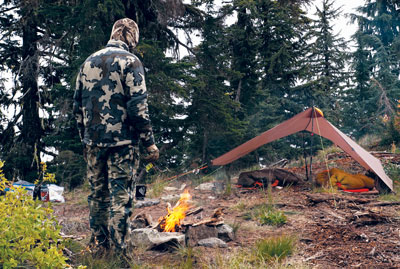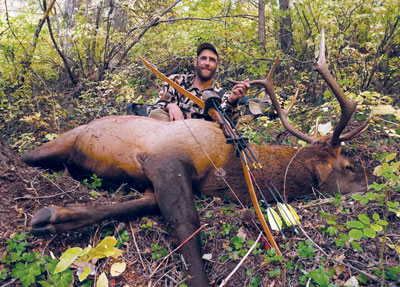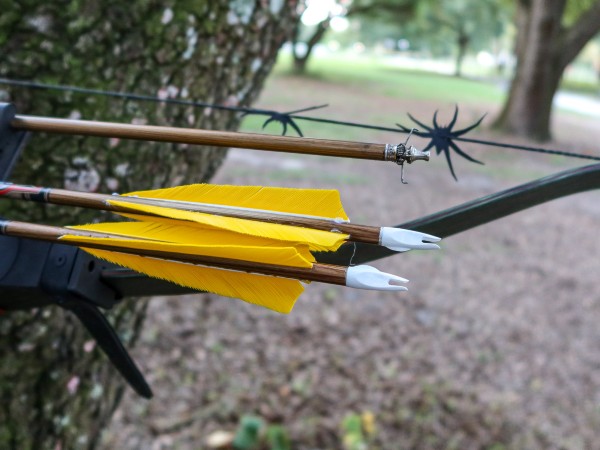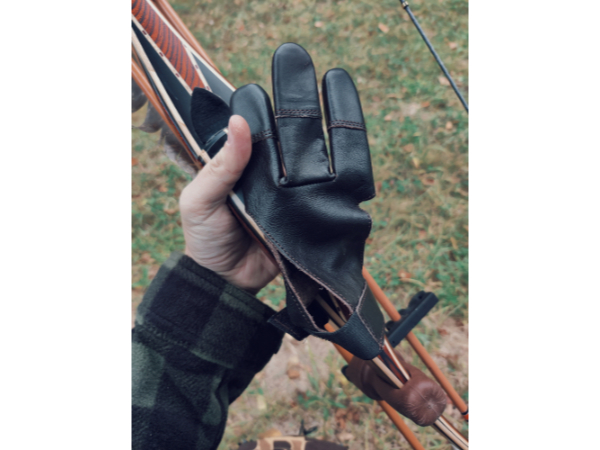“I will never go back to that place!” had barely slipped past my lips before my buddy, Fink, and I started debating our September hunt. The past three springs I had hunted bears in central Idaho. The short version is that I’d just spent two weeks hunting bears, saw a boar on the first day, about tripped on another one in the dark, and then had not seen another bear. The Bitterroot range contains rough, steep terrain that is only made worse by its ridiculously thick brush. Having drawn no other elk tags for the coming September, we were desperate to get back in the mountains for a chance to fill our first elk tags.
Fink was interested in hunting areas in the Selway Wilderness where his dad and uncles had hunted. However, after considerable online research we decided on the same zone where I had been hunting bears the past three years. Fink was hungry for a “big adventure,” so I agreed to return in September. I just didn’t want to seem afraid of what we would come to call “the Big Nasty” that fall.
Midday on September 17th, we rolled into Missoula to purchase our tags. Crossing into Idaho that afternoon we began to scout, hoping to get a feel for the terrain and hunting pressure before committing to boots on the ground. Ending up miles down a high mountain road as the sun set, we made camp. In the morning we headed off the mountain toward another trailhead we had highlighted. After days in the pickup Fink said, “I’ve had it. I’m going in here to hunt for a couple of days!” Then we loaded our packs to officially start our 2018 elk hunt.
Our goal was to hike to some large benches five miles as the crow flies from the trailhead. Nearly missing the trail to head up the ridge set the tone for the hunt. The trail was faint and hadn’t been cleared for years. Bushwhacking through brush, we climbed toward the top of the ridge dripping sweat. During a quick breather half way up the ridge, I spotted a bear across the canyon and Fink spotted a lone bull elk. As we watched, the side of the canyon came alive with critters—at least six bears eating huckleberries, and one lonely, mud covered rag-horn bull.
With evening closing in, we worked up to the main ridge line. After completely losing the trail, we located a saddle beaten flat with bear sign and a secluded waterhole surrounded by bear scat. We agreed we needed to get at least a small cushion between us and the bears to find a campsite as the sun set. As darkness fell, we were buried in alders with no idea how we would get out before we found a bare spot just large enough to sleep on.
The full moon was at a peak, and it seemed like a spotlight shining on our tarp. After a quick dinner, we couldn’t help but laugh at our situation. “I knew it was going to be steep and rough, but I never imagined it could be this thick,” Fink said. We had barely nestled into our quilts when a wolf howled near camp. “Well, that’s the end of that,” I thought. Then a bull answered the wolf’s short “ooooowwwww” with a bugle just down the ridge.
For the next few hours our camp became the hub of the wildlife world. The same lone wolf kept howling, with the bull bugling in response. The sound of leaves brushing the side of an animal followed by heavy “huffing” put me on edge immediately, and I felt certain we were in for a close encounter with a bear. I was ready to grab my pistol when a bull bugled so close I could hear his belly shaking. The elk would seem to spook, only to return shortly for a repeat performance.
Crawling from under the tarp in the morning, I ripped out a bugle with no response. Setting about our breakfast, we heard a branch break as a bull busted downhill through the brush while we stood with coffee cups in our hands. We knew he was nearly in bow range but couldn’t see 20 yards from our camp. The bull answered Fink’s call from down in the hole below us as we packed camp and looped down the ridge, finding nothing but ancient elk sign and tripping on bear scat whenever we weren’t fighting the brush.
By late morning, we were getting desperate for water. Enjoying a “picnic” by the river, we debated our next move. We hadn’t reached anywhere near our desired destination, but the brush made the terrain seem impossible to hunt. We pushed on, running into some hunters who hadn’t seen an animal in several days. Loaded with six liters of water, we climbed a thousand feet of boulders but found this area as thick as the other. We pitched the tarp between boulders that night and hiked five hours back to the truck in the morning.
Hopeful of finding more open terrain, we agreed to head to the northwest section of the unit knowing some forest fires had burned there in the past few years. Pulling into the trailhead, we found only one other truck and claimed a prime camping spot. We set out in the morning and ran into a hunter headed back to his truck. He hadn’t seen a thing in two days. We decided to keep hiking and hope to turn up something he’d missed. By midday, we were realizing that we were getting outside of our comfort zone to pack an elk out on our backs and decided time would be better spent somewhere else.
We found no other vehicles at the next trailhead, where we beat enough stakes through the rocks to get our tipi up for the night. The following morning brought mist, wind, and rain, but we set out with the same plan. With food and water for a couple of days, all we needed was a bull to fill a tag, but spotting any elk would be welcome now.
If there is one thing you can rely on it’s that Google Earth doesn’t do the terrain justice. You would think we’d have learned that, but once again after hours of hiking we realized that our target area just wasn’t realistic. As the wind howled around us, we made it another half mile before setting up a camp just off a saddle. Fink had spotted a wallow in a canyon on one side of our camp and headed for it. Finding another wet area in the adjacent canyon, I dropped 1,200 feet feeling optimistic that I’d finally get into some game. By the time I’d gone three quarters of the way down into the canyon with the sun setting, I realized I might have bitten off more than I could chew for an evening hunt. Regardless, I set up on the small, wet meadow. Forty minutes later I began working back toward camp. Having dropped into the canyon on an unmarked pack trail, my plan was to cut up the ridge to intersect the same trail.
Despite still having enough sunlight to see, I had to turn on my headlamp to locate the ground through the waist-high ferns, which soon turned to chest-high brush. This was not going to be as easy as I’d thought. Pulling myself up with brush I was still making fair time until I got into the steep part of the canyon, where I could make out steep rock to the left and right with a clear chute up the middle. A few minutes later, I realized that the chute was rock as well. Luckily, after a lot of throwing my bow up to the next ledge, I was able to inch my way up and over it a bit shaken up and wringing wet from sweat and damp foliage. A stiff breeze made it rough to sleep that night.

A midday fire at camp waiting out the fog.
We awoke to mist and heavy fog. Fink had found some fresh sign in his canyon the night before and returned to it that evening. Reluctant to repeat the previous night’s events, I stayed high on the ridge where I could glass miles of country. With both of our evenings coming up bust, we packed out the following morning. Halfway down the trail we heard a bugle way below us. That evening we walked in on another trail and heard a bugle again. We were finally getting onto a bull!
The following morning, he was still bugling regularly from across the canyon. Eventually we glassed him and his cows heading to the same area we’d thought they’d previously been. There was no trail and the canyon was deep, but we were unanimous in deciding that we needed to make a play on this bull and began busting brush his way.
After only an hour we had cleared a few drainages and were getting close to where we’d guessed the elk were. It was late morning, so we decided to wait and give the sun time to hit the bottom of the canyon. As the morning passed, we moved in. The wind seemed decent, and we felt we were close to the bedded herd. The bull answered my bugle quickly as I proceeded to rake trees only to realize he was still a couple of hundred yards away. Running uphill as fast as we could, we tried to gain ground. My excited cow calls as we ran did little to slow the bull as he left the zip code, bugling the whole way. It was clear why the herd had been where it was; no sane hunter would go there.
It was now our eighth day, and I was growing adamant about going back to our first area. At least we knew there had been quite a few bears there a week earlier. (You can tag a bear with an elk tag in Idaho.) We drove back to the first area, arriving well after dark.
The entire trip had been rough, and we were flat exhausted. Hiking in midday, we quickly set up camp in the same spot as the first night. Then Fink went out to a glassing point, while I split off to set up near the waterhole we’d found previously. As soon as the waterhole came into sight, I spotted a bear leaving it! Spending the next two hours 25 yards from the waterhole gave me time to reflect. My internal negativity, which had been growing the past few days, turned to acceptance.
The brush had just flat out eaten my soul. There was no other way to explain it. Sure, it looks beautiful from a road or trail, but when you step in, it swallows you. This became easier to accept as I considered all of our effort. We had shown up and hunted hard with no days off. We had hunted low, high, cold called, location bugled, glassed, spent a day and a half trying to get in on a bull, and now we could add sitting near water to the list. Spending 110 days hunting out West without ever shooting an arrow—50 of those for elk— was going to take a toll eventually. I felt okay about the hunt coming to a close, but I couldn’t help but think that it might be time to take a year off to re-evaluate.
That night at camp, we recognized no great options for killing an elk in the morning. The bears seemed to have moved out of the canyon as well. We were begging for a bugle as we crawled under the tarp but never heard one. With camp on our backs again, we went out to the point that Fink had been glassing from the night before, hoping to see an elk, bear, or something.
We had been glassing for an hour before Fink caught a glimpse of an elk in the least likely spot. We might have seen the bull for ten seconds before it went over the rim of the canyon. We knew it had dropped into a large patch of timber, so we hoped he’d bed there. We felt it would be best to wait until late afternoon to move in. He never bugled, but he was between us and the truck so we made him our final option.
After spending a few hours rotating positions on the same waterhole to pass the midday hours, we began trudging back around the canyon. We were both wiped out and running on fumes, but we knew we couldn’t decline to make a play on the bull. Getting around the canyon, we busted brush up to where we’d last seen him. Getting on top of the ridge and cow calling, we hoped he was still nearby.
After starting out slowly with a few cow calls, we picked up the intensity. After thirty minutes we finally heard a cow, then a bugle. We shut up in hopes of pulling him in to investigate. After 20 minutes of silence, I couldn’t take anymore. Letting out some loud, desperate cow calls, I prayed that the bull was still nearby. He answered from deeper down the canyon.
It seemed there was no option but to go down after him. That’s when he bugled again, this time seeming to have cut the distance between us in half. As we continued cow calling, brush began breaking to my left. What followed seemed like a scene from Jurassic Park. The bull crashed through brush until he came rushing in like a freight train. I finally spotted him but could only see the top of his head and antlers. As he scanned for the cows, I hoped that he didn’t come straight at us. Then his body came into view broadside at 20 yards. Cow calling to stop him, I drew and stepped to line up a shot. As if on cue, my chartreuse fletchings were in slow motion and zipping through his lungs!

The author with his first elk.
Turning to Fink, I gave him the “I just killed my first bull!” signal. A few seconds later, I turned back around to see the bull still standing nearly in the same place before he went crashing downhill. Within 30 seconds we heard him crash and expire from where we stood.
Fink couldn’t see the bull but had watched it all happen. He came running over, and the silent celebration by two guys who had never killed an elk commenced. We agreed that we needed to give him some time and were standing over him an hour later. We packed the bull out in two trips without any problems that ibuprofen and plenty of food and water couldn’t fix.
On every hunt that I’ve been on the talk of next year’s plans starts almost immediately on the ride home, but not this time. We were so wiped out that we didn’t talk of hunting at all. Fink came over the following evening to help process meat. There’s no doubt I couldn’t have done it without him, and he went home with a bag full of steaks that night, which was only a small repayment for his help and company.
After all my effort the previous years I would get a little emotional just thinking about a chance to tag a bull, but once that bull was down the excitement was outweighed by exhaustion and the work ahead. However, once the job was done and the meat taken care of, it was safe to say that our bar of “what it takes” went up several notches. We saw three bulls in ten days of the hardest hunting I’ve ever done and killed a bull in the last hour of the last day. As I sit writing this two weeks later the high has arrived, and I have a hunch it’s not going to pass anytime soon. I’ll still “never go back to that place”… well, not until next year at least.
Bob lives in north-central Iowa with his wife and their dogs. He recently started Big Stick Archery.
Equipment Note: On this hunt, the author carried a 53# Big Stick Archery “Assassin,” Gold Tip shafts, and 250-gr. Grizzly single-bevel broadheads.







Leave A Comment